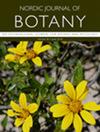中国泡桐内生根瘤菌的新发现
IF 1.1
4区 生物学
Q3 PLANT SCIENCES
引用次数: 0
摘要
以往的研究主要集中在泡桐的育种、木材供应和生理生化特性方面。然而,由于对根瘤的存在缺乏了解,人们对其内生根瘤菌及其对植物生长的潜在益处关注有限。在本研究中,我们在未栽培的三年生幸运草根中偶尔发现了根瘤状结构,随后从根瘤中分离出九种细菌菌株,并进行了 16S rDNA 和 nifA 测序,以确定细菌菌株。然后,我们测定了细菌菌株的碳利用能力和氮酶活性。16S rDNA 测序结果表明,内生根瘤菌属于农杆菌属、根瘤菌属、Herbaspirillum 属和 Burkholderia 属。nifA 测序结果表明,在菌株 PG-3、PG-5、PG-6、PG-7、PG-8 和 PG-9 中测序到的 nifA 基因多于在菌株 PG-1、PG-2 和 PG-4 中测序到的 nifA 基因。此外,菌株 PG-9 的氮酶活性明显高于其他细菌菌株。冗余分析(RDA)结果表明,果糖、葡萄糖和蔗糖与植株高度、直径和生物量的关系明显优于其他碳源和氮酶活性。我们的研究发现,从 P. fortunei 分离出的大多数细菌菌株都表现出广泛的碳利用途径,并具有在重新接种后促进植物生长的潜力。本研究旨在调查幸运草内生根瘤菌的系统发育,并扩大所研究的非豆科宿主的范围,为今后的生物固氮研究提供参考。本文章由计算机程序翻译,如有差异,请以英文原文为准。
Novel finding of Paulownia fortunei endophytic rhizobia in China
Previous research has mainly focused on breeding, timber supply, and physiological–biochemical characteristics of Paulownia fortunei. However, there has been limited attention given to its endophytic rhizobia and its potential benefits for plant growth due to a lack of knowledge about the existence of root nodules. In this study, we isolated nine bacterial strains from the root nodules after occasionally discovering the nodular-like structure in uncultivated three year P. fortunei roots and then sequenced the 16S rDNA and nifA sequencing to conduct the bacterial strain identifications. We then determined the carbon use capability and nitrogenase activity of the bacterial strains. The result of 16S rDNA sequencing indicated that the endophytic rhizobia belongs to the genus Agrobacterium, Rhizobium, Herbaspirillum and Burkholderia. The results of nifA sequencing indicated that the nifA gene was sequenced in strain PG-3, PG-5, PG-6, PG-7, PG-8 and PG-9 rather than in strain PG-1, PG-2 and PG-4. Besides, the nitrogenase activity of strain PG-9 was significantly higher than other bacterial strains. Redundancy analysis (RDA) results indicated that fructose, glucose, and sucrose were significantly related to the plant height, diameter, and biomass rather than other carbon sources and nitrogenase activity. Our research revealed that the majority of bacterial strains isolated from P. fortunei exhibited a broad carbon utilization pathway and have the potential to promote plant growth after re-Inoculation. This study aims to investigate the phylogeny of endophytic rhizobia in P. fortunei, and expand the range of non-legume hosts studied for future research on biological N-fixation.
求助全文
通过发布文献求助,成功后即可免费获取论文全文。
去求助
来源期刊

Nordic Journal of Botany
生物-植物科学
CiteScore
1.90
自引率
11.10%
发文量
100
审稿时长
2 months
期刊介绍:
Nordic Journal of Botany publishes original contributions on all aspects of the taxonomy, evolution, conservation, ecology and biogeography of plants (including algae and bryophytes) and fungi.
 求助内容:
求助内容: 应助结果提醒方式:
应助结果提醒方式:


